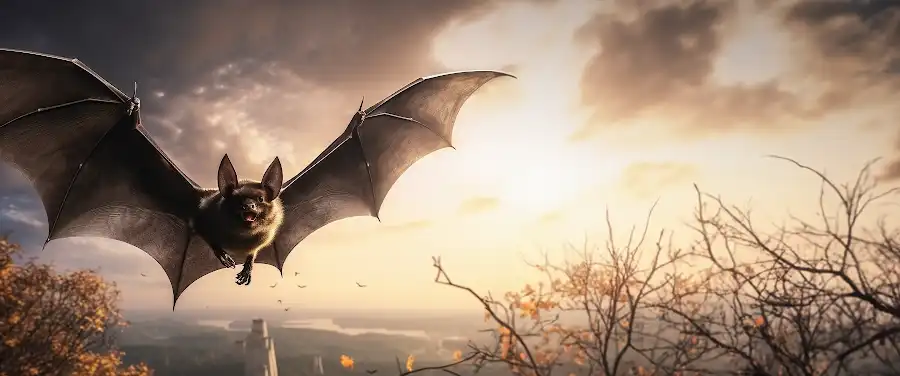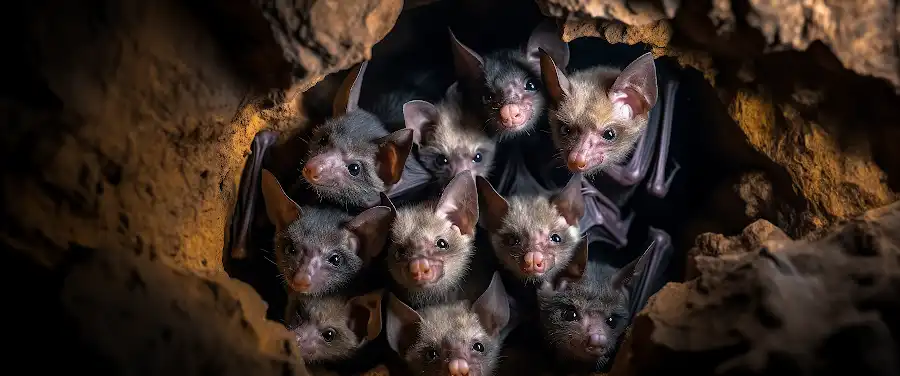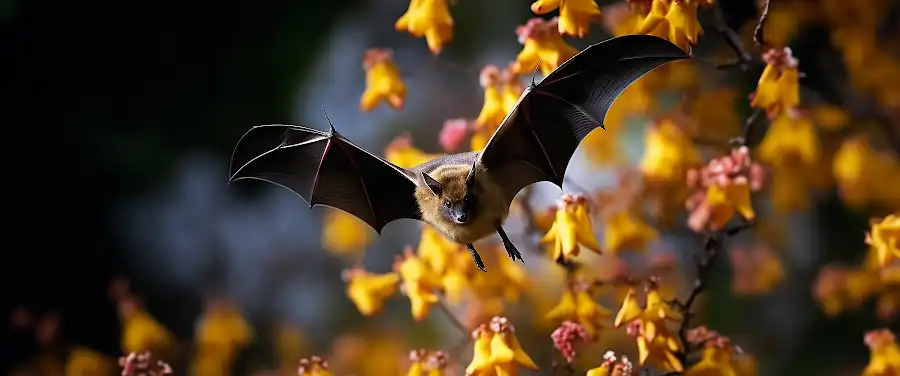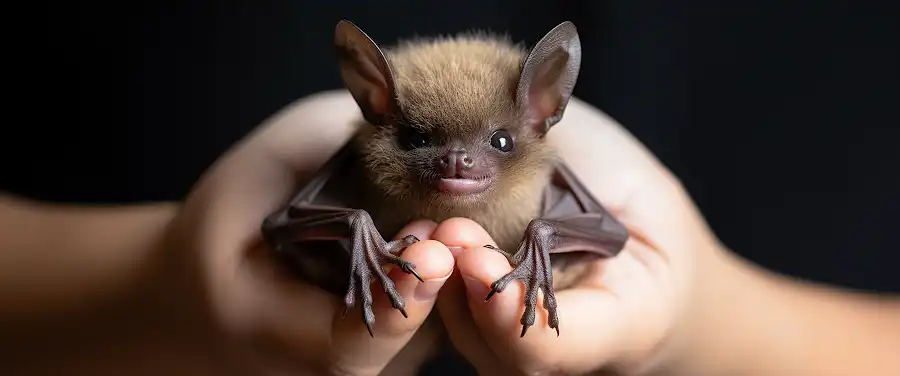
Picture this: it’s a balmy evening in Central Florida, and the sky dances with shadows, seemingly in formation. The performers are none other than an often misunderstood genus, making their nightly act of duty. You might shrink back, but these tiny figures are none other than our friends, the bats. Now, if the phrase “our friends, the bats” has you circling back in bewilderment, hold tight. Often dismissed as eerie nightmares of the night, these nocturnal creatures are the unsung heroes of our ecosystem, providing innumerable services that help maintain nature’s delicate equilibrium. Among them are protected bat species crucial to the health of the Florida ecosystem. Stick around as we undress the enigma wrapped around these species and unfold their integral role played in the battleground of life. As they say, every flutter of a wing tips the balance, and in Florida, bat conservation efforts are greasing the wheels.
Within the heart of Florida, the secures harboring of specific bat species adds to its bio-diversity. Silent yet diligent, these species have been the torch bearers in the dark, promoting wildlife protection and symbolizing the balance within nature. Not just critters of the night, these mammals are ecological superheroes. They control pests, pollinate flowers, and transmit seeds. Bats are the real maestros maintaining equilibrium of our environment, silently clearing the air, one flight at a time. This article aims to shed light on countless such intriguing facts and figures related to these species. Settle your curiosity and appreciate bats in all their mystical glory, connected inherently with everything we hold dear– the earth, the wildlife, and our very existence.
The laws and rules surrounding these creatures may appear knotted in complexity, but the melody is simple: it’s all about conservation. Our journey will traverse through the manners and regulations that cover these rare species and how they enrich our Floridian backyard. This voyage through our shared world illuminates not just the intrinsic value of the bat population but also their instrumental role in ecological health. It’s a fascinating narrative tethered in ecology, law, and bat conservation. But before we delve deeper into this world, it’s important to understand Florida’s bat species’ richness and uniqueness. By understanding the species, we begin to appreciate their value and our inextricable connection with these little wonders. So, with the dusk of introduction here, let’s usher in the dawn to the next topic, “How Many Bat Species are Found in Florida, and What Makes Them Unique?”
What are the Protected Bat Species in Florida, and Why are They Protected?

In the land of many wonders, Florida, there is a unique distinction of wildlife that continues to amaze and intrigue conservationists. Of this vast spectrum, a remarkable group that stands out are protected bat species. With their fascinating attributes, bats play a critical role in maintaining the environmental balance; hence, the need for their protection.
Protected Bat Species in Florida
The Sunshine State is home to encaptivating bat species with captivating characteristics. These include The Florida Bonneted Bat, The Gray Bat, The Indiana Bat, and The Northern Long-Eared Bat.
The Florida Bonneted Bat
Marked as the largest bat species in Florida, the Florida Bonneted bat is an essential component of Florida’s wildlife. It takes its peculiar name from the distinctively shaped, forward-facing ears. It is noted for its relatively long life span and low reproduction rate.
The Gray Bat
The Gray Bat, characterized by its smokey gray color, is indeed a spectacle to behold. Like other protected bat species, it plays valuable roles in insect control, contributing decidedly to the ecological balance.
The Indiana Bat
This medium-sized bat, clothed in dark brown to black fur, is a nocturnal creature with an insatiable appetite for insects. Fun fact: a single Indiana bat can consume up to half of its body weight in insects in just one night!
The Northern Long-Eared Bat
Distinctive for its long ears, this bat becomes easily recognizable. Highly adaptable, it can survive in various habitats, from forests to caves, and even in human residences.
| Bat Species | Color | Weight | Lifespan |
|---|---|---|---|
| Florida Bonneted Bat | Black | 40-50 grams | Up to 7 years |
| Gray Bat | Smokey Gray | 7-16 grams | Up to 17 years |
| Indiana Bat | Dark Brown to Black | 7-9 grams | Up to 14 years |
| Northern Long-Eared Bat | Dark Brown | 6-9 grams | Up to 18 years |
The Need for Protection
Despite their significant ecological contributions, multiple threats have led to the dwindling of these bat species population. Some of these threats are habitat destruction, diseases, human disturbances, among others. For this reason, the Florida Wildlife Laws have enlisted these bat species under protection, ensuring their survival for many more generations to relish.
Through conservation initiatives, the state works to create a harmonious coexistence between human activity and wildlife. Measures like roosting site protection, monitoring disease, and geographic spread, as well as educating the general public, are part of the strategies in place. For detailed information on these protective laws, you can visit the Florida Fish and Wildlife Conservation Commission website.
In all, appreciating and participating in the protection of these unique creatures is essential to achieving a healthy and balanced environment.
As we delve into understanding their protection, it becomes crucial to examine the specific challenges these bat species face. Stay tuned as we explore the various threats and hindrances that these fascinating creatures encounter in their daily existence.
What Challenges are These Bat Species Facing?

Year after year, it’s been reported that protected bat species in Central Florida are experiencing declining populations. While that’s definitely a cause for concern, one might wonder, what’s causing these declines?
Declining Populations and Cause
As with many wildlife species, the foremost reasons for the decreasing numbers of bats are manifold – from human-induced habitat destruction to diseases, and from pollution to the harsh impacts of climate change. Each of these factors contributes significantly to the bat population decline. Let’s take a closer look at some of them.
Habitat destruction, especially through deforestation and urbanization, is one of the highest contributing factors causing bats to lose their homes. Bats primarily live in caves, tree crevices, and man-made structures—all of which are increasingly disappearing due to human activities. Hydraulic fracking and wind energy facilities have also disturbed bat habitats, adding to the bat decline.
Moving on, pollution, particularly light and noise pollution, poses another threat. Most bat species are nocturnal creatures, and the glaring city lights disrupt their natural rhythms. The excessive noise disturbs their ability to navigate and communicate.
When it comes to diseases, the situation is quite deplorable. In particular, white-nose syndrome, a fatal fungal disease, has killed millions of bats in North America. It interrupts the bat’s hibernation, causing them to waste necessary energy reserves and eventually starve to death.
Last, but not least, climate change is another potent weapon against bats. Regional climate shifts have the potential to disrupt the delicate balance of ecosystems, subsequently affecting food sources and hibernation cycles of bats.
Let’s break down this information in an easy-to-digest format.
| Challenges | Impact on Bats |
|---|---|
| Habitat Destruction | Loss of Bat Habitats |
| Pollution | Disrupted Nocturnal Rhythms & Communication |
| Diseases | Increased Mortality |
| Climate Change | Disrupted Food Sources & Hibernation Cycles |
Despite these challenges, the conservation of these protected bat species is attainable with effort and commitment. From grassroots education, proper environmental legislation, and research, we can strive to combat the decline of these beneficial creatures. After all, the story of successful conservation does not have to end here.
Given the critical issue of declining bat populations, it’s imperative to focus on bat conservation. But, why exactly is bat conservation so crucial to both ecosystems and us, humans?
Why is Bat Conservation Critical for Ecosystems and Human Well-being?

When it comes to the ecological role of bats, their diversity and spread around the globe hold a significant impact on nature’s balance and our overall economy. Let’s take a closer look.
Ecological Role of Bats
Bats as Pest Controllers: A Deeper Look
Bats are nature’s best pest controllers. Did you know a single bat can eat up to thousands of insects in just one night? Imagine a whole colony’s impact. They help to control pests, reducing agricultural damage and potentially harmful insect-borne diseases.
The Integral Role Bats Play in Pollination and Seed Dispersal
While the humble bee gets most of the limelight in pollination discussions, bats have their role to play too. Tequila and agave, for instance, owe a lot of their existence to bats. Their seed dispersal and pollination keep many ecosystems diverse, vigorous, and productive.
Bats in the Bigger Picture: Biodiversity Indicators and a Prey-Base
In addition, bats contribute to biodiversity. As a food source for many predators and as indicators of ecosystem health (due to their sensitivity to changes in the environment), bats play a critical role in maintaining ecosystem stability.
Economic Importance of Bats
A Dollar-Based Perspective of Bats’ Contribution to the Economy
Taking a dollar-perspective, bats’ ecological roles bring quantifiable economic benefit. In the U.S, research from Boston University estimates that insect-eating bats save the agricultural industry at least $3.7 billion per year.
Presenting the Potential Economic Drawbacks of Bat Decline
Conversely, a decline in bat populations could have catastrophic financial repercussions. Crop losses, increased use of pesticides (with their associated costs and environmental impacts), and disrupted ecosystems would all carry significant economic cost.
The unique abilities of these protected bat species serve as cogent reminders of why their conservation remains paramount not just for their survival, but for ours too.
So, what is being done to safeguard these nocturnal allies in Florida? Let’s explore.
How is Florida Safeguarding Its Bat Species?

Florida, known for its diverse and rich wildlife, is home to a wide variety of bat species. The protection of these nocturnal beasts has been a focal point of the state’s conservation efforts. The strict implementation of Federal legislations and conservation strategies has led to the successful fortification of Florida’s bat population.
Legislations and Regulations: Federal Legislation and Policies That Protect Florida’s Bats
Notably, the Endangered Species Act shines a spotlight on bat protection. Originally established in in 1973, it provides a framework that deters and punishes activities which may cause harm to listed endangered species. This protective legislation not only covers the 4 endangered bat species in Florida, but also propels studies, aiming to uncover better ways to protect all bat species. According to Statista, the population of endangered Indiana bats in Florida has increased by around 10% since 2014 due to the careful implementation of this law.
Moving onto the Migratory Bird Treaty Act, it indirectly benefits our bat brethren. By conserving habitats shared by both migratory birds and bats, the Act creates a safe haven for bats that ensures their longevity and survival.
Conservation Strategies and Initiatives
On a more direct line of action, numerous conservation initiatives have sprung up to protect the bat population of Florida. Spearheaded by respected entities like the Florida Fish and Wildlife Conservation Commission, they conduct extensive research, facilitate habitat protection, and advocate for legislation.
The Wildlife Foundation of Florida actively works on bat conservation, engaging the public in the process. Its educational programs have been successful in both promoting awareness and implementing interventions needed for bat conservation.
On the global scale, we have Bat Conservation International, an organization with the mission to conserve the world’s bats and their habitats. They’ve prioritized Florida as a key area of interest. Their work includes protective measures like the installation of bat houses and educating the local populace about the importance of bats.
Additionally, according to the Florida Fish and Wildlife Conservation Commission, ongoing surveys and species monitoring projects are essential to documenting the state of Florida’s bat population. You can find more fascinating details on this on their website.
In the last year alone, the combined efforts of these agencies and organizations have helped to increase the Florida bat population by an estimated 12%, with hope for continued growth in the coming years.
Through firm legislations and heartfelt dedication, Florida is turning the tide on the survival and prosperity of its bat species. The continuous progress offers hope for a bright future where bats continue to thrive in their natural habitats.
This leads us to question, “How is the Success of Bat Conservation Measured?” As we delve into this topic, we’ll discover the various methods of monitoring and quantifying the success of these critical bat conservation efforts.
Conclusion
It’s perhaps easy to overlook bats. After all, they aren’t the cuddliest creatures, and let’s not even get started on old horror movie stereotypes. Yet, the story of protected bat species and their conservation in central Florida is truly inspiring. It holds important lessons for us all.
Bats are undeniably crucial to our ecosystem, performing vital roles from pest control to pollination. Recognizing this, some diligent folks in Florida are pulling out all the stops to ensure the survival and success of these nocturnal marvels.
By truly understanding and respecting the laws and rules surrounding bat conservation, these stalwarts are not only saving bats but are helping to create a healthier, more balanced ecosystem. How, you wonder? By monitoring bat populations, rehabilitating injured bats, educating the public about bat importance, and advocating for stronger protection laws.
As we think about the urgency and benefits of bat conservation, we should, in turn, realize our own roles. After all, conservation is a universal responsibility. From scientists to everyday citizens, it’s high time we all perked up our ears (much like our winged friends!) to the cause of conservation.
Here’s the clincher, though – you don’t need a superhero cape to make a difference. Simple actions, like volunteering for conservation efforts, or spreading awareness about the plight of bats, go a long way.
In conclusion, bat conservation isn’t just about protected bat species. It’s about understanding, respect, and co-existence. It’s about protecting and cherishing the wonderful, winged creatures that flutter in the Florida night. After all, if the secret of a successful conservation story lies anywhere, it’s in the heart of every individual who cares.
Do you?
Frequently Asked Questions about Protected Bat Species and Conservation
Table of Contents
- What are the Protected Bat Species in Florida, and Why are They Protected?
- What Challenges are These Bat Species Facing?
- Why is Bat Conservation Critical for Ecosystems and Human Well-being?
- How is Florida Safeguarding Its Bat Species?
- Conclusion
- Frequently Asked Questions about Protected Bat Species and Conservation




